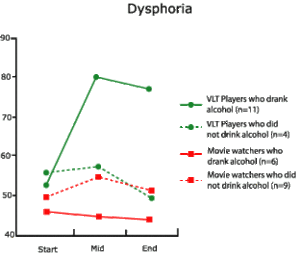Several issues of the WAGER have discussed research pertaining to comorbid drinking and gambling (see WAGERs 7(20), 4(39), 4(38), 4(8)). This body of research demonstrated relatively frequent comorbid occurrences. This week the WAGER reports on recent research that relates drinking while gambling with bad moods (Stewart, McWilliams, Blackburn, & Klein, 2002).
The researchers recruited 30 regular, at least monthly, Video Lottery Terminal (VLT) players via newspaper advertisements. Participants went to an experimental laboratory designed to look like a bar. There participants were paid $50CAN for their participation and completed a battery of baseline assessments including a gambling screen, the South Oaks Gambling Screen (SOGS), and a mood assessment, the Revised Multiple Affect Adjective Check List (MAACL-R). After the participants finished these assessments, the researchers randomly assigned the participants to either play 90 minutes of VLT or watch a movie for 90 minutes. Stewart et al. told participants that during the 90 minutes they could buy as many non-alcoholic drinks as they wanted and up to 3 alcoholic drinks and that researchers would interrupt them after 45 minutes to complete the MAACL-R a second time (i.e., a midpoint assessment). After 90 minutes, participants completed the MAACL-R a third time (i.e., an endpoint assessment).
As Figure 1 illustrates, VLT players who chose to drink were the only group that showed a statistically significant increase in negative mood (i.e. dysphoria). VLT players who chose to drink did not differ from other participants in negative mood at baseline, but this group was significantly more negative than the other groups both at the Midpoint and Endpoint mood assessments.
This study is the first to demonstrate a real-time relationship between drinking, betting, and mood. Some limitations include the small sample size and unnatural study setting. Further, participants self-selected into drinking and non-drinking groups. These limitations could confound results and reduce the ability to generalize these results to larger populations.
Despite these concerns, this research takes important first steps towards untangling the relationship between drinking and gambling. As researchers accumulate more information about these co-occurring patterns of behavior, treatment providers will be better informed about the mood patterns associated with gambling. This information might help clinicians adjust treatment plans to account for such patterns.
Comments on this article can be addressed to Debi LaPlante.
References
Stewart, S. H., McWilliams, L. A., Blackburn, J. R., & Klein, R. M. (2002). A laboratory-based investigation of relations among video lottery terminal (VLT) play, negative mood, and alcohol consumption in regular VLT players. Addictive Behaviors, 27, 819-835.





